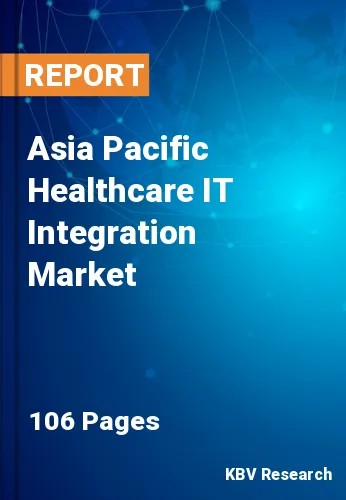The Asia Pacific Healthcare IT Integration Market would witness market growth of 14.8% CAGR during the forecast period (2021-2027).
Developing countries, such as India, which already spend a lower percentage of GDP on healthcare, are searching for methods to cut costs, and one way to do so is to include IT into the healthcare system. If these countries intend to reduce their healthcare spending, they must establish a more targeted healthcare policy. Comprehensive data regarding the past, present, and future conditions, as well as projections for the future, is essential for any strategy to be executed, which is woefully lacking in these countries.
Patients are frequently asked to undergo tests, and the fees connected with these tests are extremely high. These tests could have been conducted before by another doctor at a different lab, but due to a lack of a reliable database for patient information, patients are frequently required to repeat them. This increases the overall expense of healthcare. By developing a complete database for patients' information, such as an Electronic Medical Record, and linking it with other medical departments, IT in healthcare helps reduce the number of repetitive tests (EMR).
The government of Singapore's COVID-19-fighting efforts has shown to be effective. One of these strategies was to collect statistics on the entire population of the country. The country used digital technologies in conjunction with the Health Ministry's risk stratification approach to achieve care model adoption. The plan called for the employment of remote monitoring technologies in newly established Community Care Facilities (CCFs), with manpower devoted to high-risk patients.
As the outpatient care segment in the region continues to develop at an unprecedented rate, the scope of expansion for players in the healthcare IT integration market will expand as well. Furthermore, regarding public health programs, the majority of Asian countries have made it a point to prioritize non-communicable diseases, thereby contributing to preventative healthcare measures.
The China market dominated the Asia Pacific Healthcare IT Integration Market by Country 2020, and would continue to be a dominant market till 2027; thereby, achieving a market value of $599.3 million by 2027. The Japan market is estimated to grow at a CAGR of 14.1% during (2021 - 2027). Additionally, The India market would display a CAGR of 15.6% during (2021 - 2027).
Based on Offering, the market is segmented into Services and Products. Based on Services Type, the market is segmented into Support & Maintenance Services and Implementation & Integration Services. Based on Products Type, the market is segmented into Interface/Integration Engines, Medical Device Integration Software, Media Integration Software, and others. Based on End User, the market is segmented into Hospitals, Laboratories, Clinics, Diagnostic Imaging Centres, and others. Based on countries, the market is segmented into China, Japan, India, South Korea, Singapore, Malaysia, and Rest of Asia Pacific.
Free Valuable Insights: The Worldwide Healthcare IT Integration Market is Projected to reach USD 7.9 Billion by 2027, at a CAGR of 12.8%
The market research report covers the analysis of key stake holders of the market. Key companies profiled in the report include Siemens Healthineers AG (Siemens AG), AllScripts Healthcare Solutions, Inc., General Electric (GE) Co. (GE Healthcare), NextGen Healthcare, Inc., Epic Systems Corporation, IBM Corporation, Oracle Corporation, Infor, Inc. (Koch Industries), Koninklijke Philips N.V., and Wipro Limited.
By Offering
By End User
By Country
Our team of dedicated experts can provide you with attractive expansion opportunities for your business.

